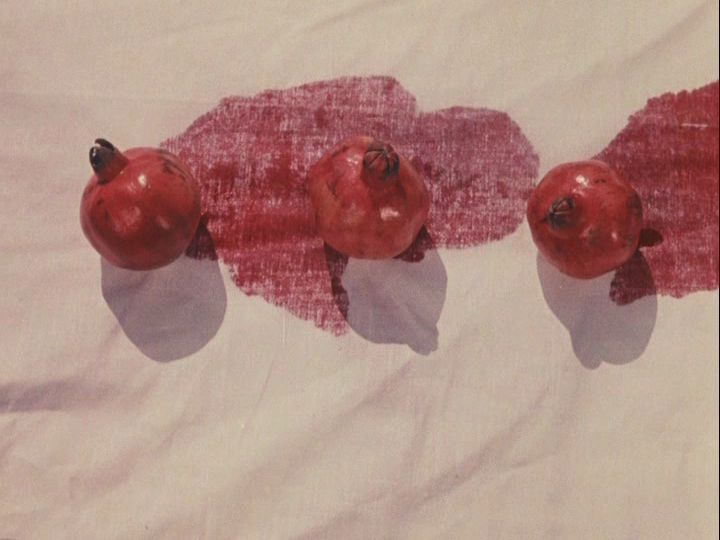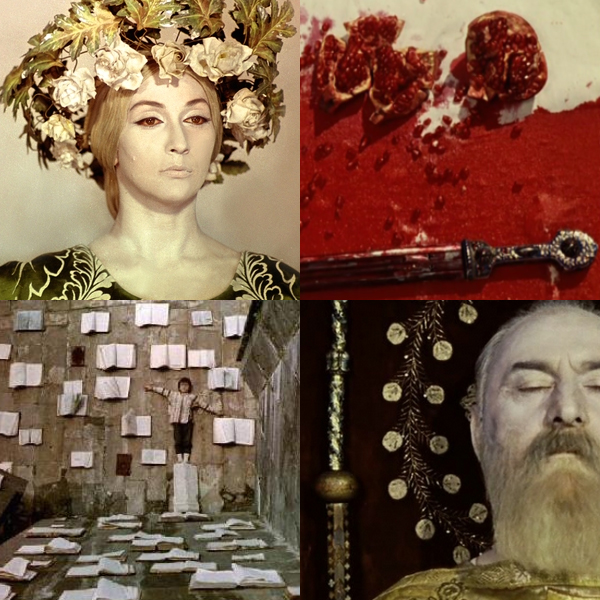NYFF: From Russia with Love and 'Pomegranates'
 Wednesday, October 1, 2014 at 7:00PM
Wednesday, October 1, 2014 at 7:00PM New York Film Festival isn't just about the new. Here is Glenn on the restoration of Sergei Parajanov's 1968 avant-garde classic 'The Color of Pomegranates'.
Conversing at a bar last Friday night after the premiere NYFF screening of David Fincher’s Gone Girl, I mentioned to Nathaniel that I knew what shot I would choose for “Hit Me With Your Best Shot”. I’m not sure about you, but I frequently find myself attempting to work out what my selection would be when I watch a movie. As I’ve mentioned previously, I am very much into the visual and formal aspects of a film so whether it’s a cheap horror movie or a prestige epic my eyes attempt to scope these things out.

Which brings me to the restoration of Sergei Parajanov’s The Colour of Pomegranates (also known as Sayat Nova). This, quite frankly, is a film in which it would be impossible to find just one single piece of imagery to label the best. Would it be the juices of a carved pomegranate soaking through a piece of white linen? How about the moment when a large woolen rug is being warmed in the sun atop dome-like structures? Or when a woman dressed in deep red garb lifts a veil in front of her eyes? Or the fluttering of a hundred books adorning the angular walls upon which a young boy lays? A shell, shimmer with mother of pearl, placed delicately on top of a woman’s breast? A foot placed parallel to a sprig of ripened red grapes? Sofiko Chiaureli with her face plastered white wearing a stunning tapestry-like dress and a headdress maid of leaves and flowers, a chicken mysteriously roosted on her shoulder? There are genuinely too many moments of virtuosic imagery on display to pick just one.
Inspired by the poems of Sayat Nova and subsequently banned in what was then the Soviet Union, The Colour of Pomegranates is likely the best film I’ll see at the entire festival. Yes, it’s nearly 50 years old, but there’s no statute of limitations on that. Bold in its avant-garde imagery, mesmerizing in its patience; at only 77 minutes it is well and truly an epic. A film about poetry that is in and of itself poetic. Himself surely inspired by fellow countryman Dziga Vertov amongst others, Parajanov’s film has inspired countless others. Tarsem Singh’s films - The Cell and The Fall especially - are indebted to the lush blend of natural landscapes and otherworldly design and fantastical artifice, while works by Federico Fellini, Madonna, Steven Klein, Peter Greenaway, Alejandro Jodorowsky and Ron Fricke all have clear references to its unconventional brilliance as well.

46 years after its debut, the film has been beautifully restored by Cineteca di Bologna/L’Immagine Ritrovata and The Film Foundation’s World Cinema Project, in association with the National Cinema Centre of Armenia and Gosfilmofond of Russia. It has played played Cannes, the Academy, Toronto (introduced by Martin Scorsese), and now New York Film Festival and is a must see. Whenever a film finds itself given a 4K make-over like this it suggests a significant blu-ray (hopefully Criterion) release is on the horizon and the more people able to see Parajanov’s stunning achievement in such high quality the better. On a big screen, however, it will blow your mind. A
The Colour of Pomegranates screens only once on Tuesday Oct 2 (6pm)
 NYFF,
NYFF,  Russia,
Russia,  documentaries
documentaries 


Reader Comments (6)
Oh how I wish that this would find its way to a Criterion blu-ray release. To my knowledge, Kino still holds the rights to this, and while the DVD transfer they did sometime ago still holds up, a significant restoration is highly overdue.
Parajanov often gets overlooked in comparison to his more prolific and accessible Soviet counterpart, Andrei Tarkovsky, yet he is still vital to the development of world cinema, and especially the more lyrical Eastern European cinema ala Sokurov that we see today.
Jason, one website I found had a comparison of all four major DVD releases and the images did not look as good as what Blu-ray would, obviously, but don't lose faith. If somebody is going to the effort of doing an extensive *4K* remaster then it's not just going to play a few festivals and then languish on a harddrive somewhere. Expect a blu-ray release in the future, even if as you say Kino hold the rights. There was no Kino logo before the remastered movie though so...
As for the director, this is the first of his works that I have seen, but I am keen to seek out more (however hard that may be on the big screen). I find it interesting that, and perhaps this is my lack of Russian cinema knowledge shining through but, most of the people who have been inspired by this film are westerners and less so Russian filmmakers. although, that may have something to do with avant-garde cinema having a harder time in today's cinema landscape where there are plenty of indie films to satiate a desire for new voices.
It is indeed a gorgeous film and apparently Paradjanov's "Shadows of Our Forgotten Ancestors" (which I think won a Palme d'or) is meant to be just as striking, though I wouldn't know if it is, since it's freaking impossible to find!
Glenn, it's hard to find works of his because there's really only four extant works that are readily available. He made earlier films in the vein of Soviet realism that Parajanov himself disowned or are now lost. His first true film was Shadows of Our Forgotten Ancestors, which has more of a narrative feel to it compared to Pomegranates, but is just as powerful visually.
His other two works came after years of being imprisoned during the 70s, and when Parajanov was in poor health to a certain extent. The Legend of Suram Fortress is similar to Pomegranates in that its story is from the stories and literature of the Caucus region where he was from, while Ashik Kerib is more visually based in the avant-garde. I'd say that Forgotten Ancestors is essential viewing to Soviet cinema, with the other two being more for completists of his work.
Sadly, those were the only four feature length films Parajanov completed before his death. More information (and some surviving fragments of the last film he was working on) can be found in the produced documentary, Paradjanov: The Last Spring.
As far as his impact on Russian filmmakers, his influence is not as readily apparent as someone like Tarkovsky is. This is for the simple reason that, as previously stated, much of his work was censored in the sixties and seventies, hence only western countries saw close to completed versions of his work. But there is still some influence there, particularly on Sokurov from a visual sense and moreso Zvyagintsev in both a narrative and visual sense with his film The Return.
At least, that's what I see.
Fascinating. Thank you very much for the info!
All of Sergei Parajanov's known films survive, except for his VGIK diploma film A Moldovan Fairy Tale. In fact his early features have been shown with English subtitles at various retrospectives, but they have never received DVD releases in the US. You can even find some of them on YouTube. I write about his early films and many of his unfilmed screenplays in my recently published book The Cinema of Sergei Parajanov (University of Wisconsin Press, 2013).
Agreed, it seems likely that someone will release the restored version of The Color of Pomegranates on Blu-ray. I personally am thrilled that the Film Foundation/World Cinema Project was able to raise the funds for a full 4k restoration and hope it brings a new audience to Parajanov's masterpiece.